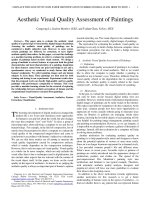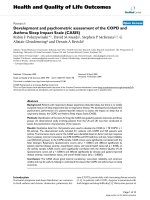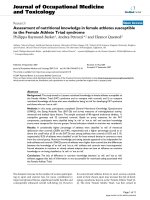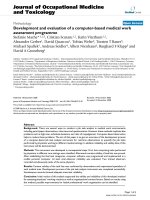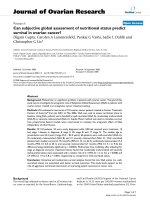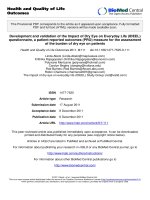Baby corn candy: Development and assessment of nutritional, sensory and storage quality
Bạn đang xem bản rút gọn của tài liệu. Xem và tải ngay bản đầy đủ của tài liệu tại đây (339.6 KB, 12 trang )
Int.J.Curr.Microbiol.App.Sci (2018) 7(3): 2261-2272
International Journal of Current Microbiology and Applied Sciences
ISSN: 2319-7706 Volume 7 Number 03 (2018)
Journal homepage:
Original Research Article
/>
Baby Corn Candy: Development and Assessment of Nutritional,
Sensory and Storage Quality
D. Shobha*, M.S. Sreedevi and Puttaramanaik
Zonal Agricultural Research Station, V.C. Farm, Mandya-571405, Karnataka, India
*Corresponding author
ABSTRACT
Keywords
Osmotic dehydration,
Blanching,
Rectangular candy,
MPP
Article Info
Accepted:
20 February 2018
Available Online:
10 March 2018
The quality of baby corn candy prepared with four different sugar concentrations
(20/30/40°B, 30/40/50°B, 40/50/60°B and 50/60/70°B) in two different shapes
(Rectangular and Whole) was evaluated for acceptability and storage stability. The sensory
scores of rectangular shaped candies prepared from 40/50/60°brix scored between “like
very much to like extremely” in terms of overall acceptability (8.2) compared to other
treatments. Optimum sugar concentration of 40/50/60°brix with 24 hours steeping resulted
in water loss and solid gain of 32.25 % and 7.33 %, respectively. The analyzed nutritional
quality of 40/50/60°brix rectangular candy is as follows; ash (2.2%), fat (0.5%), protein
(1.93 %), crude fiber (1.95 %), carbohydrate (86.0 %), calcium (24 mg), magnesium
(85.33 mg), iron(0.23 mg) and phosphorus (64.13 mg) contents. From storage studies, it
was revealed that the rectangular candy has better sensory traits when stored for six
months in MPP pouches at ambient condition with good retention of flavor, taste and
texture without any adverse effect on nutritional quality. Consumer acceptability for
school children’s conducted in three different locations at V.C. Farm, Hassan and Mandya
indicated that maximum number (82.2 %) of consumers rated the candy as “very good”
followed by good (11.1%) and not good (6.6%), respectively.
Introduction
Baby corn (Zea mayz L.) is the small young
ear before pollination and is an important
vegetable product (Lekagul, 1994). Corn has
wider adaptability, high yielding ability and
fast growing habit and hence emerged as a
potential alternative crop to diversify
sustainable agriculture. In India baby corn
production and processing industries are still
in early stage which needs to be developed
through combined efforts of producers,
processers and consumers. Baby corn and its
processed products are being exported from
India to many other countries with Thailand
and Taiwan being the largest exporters
(Aggarwal and Kaur, 2010).
Baby corn is a very economic crop as the
farmers get an estimated net income of Rs.
16,000/- per acre from single crop (Kapoor,
2002). The lack of knowledge about the use
and economic importance of baby corn and
non-availability of appropriate production
technology are the major constraints for its
popularization among Indian maize growers.
2261
Int.J.Curr.Microbiol.App.Sci (2018) 7(3): 2261-2272
However, baby corn cultivation is now
picking up in Meghalaya, Western Uttar
Pradesh, Haryana, Maharashtra, Karnataka
and Andhra Pradesh (Kheibari et al., 2012).
Majority of baby corn produced is going for
raw cob consumption as a safe vegetable and
it also finds place in most of the restaurants,
hotels and motels as decorative crispy
vegetable in salad, soup, pickles, pakodas,
vegetable biryani, pasta, chutney, cutlets, chat,
dry vegetable kofta, curry, manchurian, raita,
jam, murabba, burfi, halwa, kheer, deep fried
baby corn with meat, rice and other favorite
dishes (Asaduzzaman et al., 2014).
Baby corn nutritive value is quite comparable
to any other seasonal vegetable. Besides
proteins, vitamins and iron, it is one of the
richest sources of phosphorous and easy to
digest. It is the most “safe” vegetable to eat as
it is almost free from residual effects of
pesticides due to wrapping of young cob with
husk and well protected from insects and
diseases (Kawatra and Sehgal, 2007). Baby
corn can be consumed either raw or cooked.
Processing of baby corn into value added and
shelf stable products are needed as fresh corns
begin to deteriorate quickly after harvest. In
order to overcome this problem, timely
harvesting of baby corns within 2-3 days of
silk emergence (1-2cm) is suggested. In spite
of its popularity as a fresh vegetable in Asia,
systematic research on the processing,
preservation and storage behavior to extend
the nutritional and agricultural potential of this
crop is lacking. Since baby corn has typical
bland taste huge scope exists for value added
products. Various products can be prepared by
adopting low cost technologies which in turn
increase the income of farming community.
Traditional low cost processing technologies
are available for preservation of fruits and
vegetables like drying, dehydration, pickling,
brining, fermenting and osmotic dehydration.
The most widely used method for preservation
of fruits and vegetables is osmotic
dehydration. During osmotic treatment several
flows occur simultaneously; loss of water
from the product to the hypertonic solution,
solute impregnation from the solution to the
food matrix and additionally, loss of other
compounds (mainly soluble solids) from the
product to the solution (Chenlo et al., 2002).
Literature on osmotically dehydrated product
preparation from fruits and vegetables is
available in large numbers such as cashew
apple, pineapple slices, West Indian cherry,
pineapple cubes, tomato candy and ginger
candy (Azoubel and Murr, 2003; Thakor and
Sawant, 2008; Silva et al., 2012; Paul, 2014;
Hasanuzzaman et al., 2014 and Patil et al.,
2015), respectively. However, osmotic
dehydration of baby corn with different ratios
of sugar concentration and its acceptability as
candy has not been studied. Hence, this study
was taken up to assess the suitability of baby
corn for candy preparation and its quality in
terms of sensory, nutritional and microbial
load.
Materials and Methods
Baby corns were harvested from the
Experimental plots of the All India
Coordinated Research Project on Maize, Zonal
Agricultural Research Station, V.C. Farm,
Mandya. The selected baby corns (two days
after silk emergence) were de husked and the
silk was removed by hand. The freshly
harvested baby corns were analyzed for
physical parameters such as length and
breadth using Vernier calipers (Mitutoyo
Digimatic Caliper) and weight of the corn
with and without husk was weighed in grams
using electronic weighing balance. The
nutritional composition of fresh baby corn was
analyzed as per Ranganna (2001).
Preparation of baby corns
For osmotic dehydrated candy preparation,
two different shapes were made; Whole (W)
2262
Int.J.Curr.Microbiol.App.Sci (2018) 7(3): 2261-2272
baby corns were trimmed to get uniform sized
corns of 7-8 cm length and 1.04-1.05 cm
breadth and rectangular (R) pieces with 4.0 cm
length and 1.04 cm breadth.
W2= Final weight of the sample after osmosis
(g)
W3= Oven dried weight of the sample after
osmosis (g)
Method of candy preparation
Prior to osmotic dehydration, two types of
corns (W and R) were weighed and subjected
to hot water blanching three minutes along
with addition of 0.2 % sodium meta-bisulphate (KMS) to the boiling water.
To standardize the recipe for preparation of
baby corn candy, the W and R baby corns
were steeped in four different combinations of
sugar concentrations(20/30/40°B, 30/40/50°B,
40/50/60°B and 50/60/70°B) for 24 hrs in each
concentration to facilitate osmosis by keeping
the sample to solution ratio as 1:3.
Citric acid and KMS were added to osmotic
solution at the rate of 0.05% to enhance the
keeping quality of the candy. The osmosed
baby corns were dried at 60°C for 8 hrs to
reach final moisture content of 10-11 per cent.
M1= Initial moisture content of the sample
before osmosis (% wb).
Sensory evaluation
In order to select the best acceptable product,
eight
osmotically
dehydrated
candies
(Rectangular candy; RC and Whole candy;
WC) were subjected to sensory evaluation by
semi trained judges. Panelists (N=21) were
provided with coded samples along with glass
of water and instructed to rinse and swallow
water between the samples. Panelists were
given written instructions and asked to
evaluate the products for acceptability based
on its appearance, color, taste (aroma and
sweetness), texture and overall acceptability
on nine-point hedonic scale (Amerine et al.,
1965).
Nutritional composition of baby corn candy
Osmotic dehydration characteristics
The pattern of osmosis in terms of weight
reduction (WR), solid gain (SG) and water
loss (WL) were determined for selected candy
by employing equations provided by Patil et
al., (2015).
(W3-W1 x (100-M1) /100)
Solid gain (% wb) = ----------------------- x 100
W1
W1= Initial weight of the sample (g)
Storage study
RC and WC were packed in MPP (Metalized
Polyester Polyethylene laminate) pouches and
stored under room temperature (25-30o C, 65
% RH) for a period of six months to assess the
shelf life of the products.
W2-W1
Weight reduction (%) = ------------ x 100
W1
Water loss (% wb) = WR+SG
Developed baby corn candies were assessed
for nutritional composition as per Ranganna
(2001).
Assessment of bio-chemical and sensory
quality
The parameters such as pH, moisture, titrable
acidity and ash (Ranganna, 2001) as well as
acceptability of candy in terms of sensory
2263
Int.J.Curr.Microbiol.App.Sci (2018) 7(3): 2261-2272
parameters were assessed every month during
storage (0-6 months).
candies as per Steel et al., (1997) for
determining the effect of storage on different
quality parameters.
Analysis of nutritional composition
Results and Discussion
Based on the biochemical and sensory quality,
only one type of candy was taken for
assessment of nutritional composition such as
proximate, calcium and phosphorus (AOAC,
1995), carbohydrate and mineral contents
(Livesey, 2001). Magnesium and iron contents
were determined by Versanate titration and
Wong’s method, respectively. Vitamin C
content in fresh baby corn and candies was
analyzed by 2, 6-dichlorophenol indophenol
titration method as quoted by Ranganna
(2001).
Physical characteristics of fresh baby corn
Physical characteristics of fresh baby corn
revealed that the average weight of baby corn
with husk, without husk and weight of husk
and silk were in the range of 48.86, 8.06 and
40.80 g, respectively. The average length and
breadth of fresh baby corn were found to be
7.16 and 1.04 cm, respectively. Similar results
for length and breadth were reported by
Aggarwal and Kaur (2010) for baby corn
harvested after two days of silk emergence.
Microbial analysis
Nutritional composition of fresh baby corn
Microbial load including bacteria, moulds and
yeasts of stored candies were analysed
according to APHA (1984) by drawing the
samples every month.
Even the osmotic exudate (sugar syrup
obtained after draining of baby corn) was
examined every month for clarity, visual
growth of microorganisms, changes in pH and
TSS content.
Consumer acceptability
The best acceptable candy was distributed to
school children (n=30) at three locations such
as V.C. Farm, Hassan and Mandya to elicit the
consumer acceptability of the product by
rating the product as “very good”, “good” and
“not good”.
Statistical analysis
The data was subjected to ANOVA for
preliminary sensory evaluation and nutritional
composition studies while two-way ANOVA
was used for storage study of two shapes of
The nutritional quality of baby corn is
presented in Table 1. The fresh baby corn had
a moisture content of 86.41%. The crude
protein, fat, crude fiber, ash and carbohydrates
were in the range of 2.90, 0.90, 3.42, 1.34 and
9.13, respectively.
The mineral and energy contents in this study
were in the range of 25.77 mg for calcium,
magnesium (85.87 mg), phosphorus (84.10
mg), iron (0.32 mg) and energy (56.55 k.cal).
Our findings are in accordance with the values
reported
by
Anuradha
(2012)
for
carbohydrate, protein, calcium, phosphorous
and iron contents in fresh baby corn.
Development and osmotic dehydration
characteristics of baby corn candy
Prior to candy preparation, the baby corns
were subjected to water blanching containing
0.2 % KMS solution for three minutes was
found to be sufficient to retain the colour of
the product. However, Aggarwal and Kaur
(2010) reported four minutes water blanching
2264
Int.J.Curr.Microbiol.App.Sci (2018) 7(3): 2261-2272
time was optimum to retain the colour of the
product which increase the permeability of the
skin and prevent the browning reactions. On
the contrary, Singh et al., (2007) reported
blanching followed by dipping in 0.3%
solution of KMS for 3 min helps to retain the
colour and vitamins. Beneficial effect of
blanching with KMS/sulphitation on retention
of ascorbic acid content of dried product was
also observed by many workers (Sethi, 1986;
Tripathi et al., 1988; Sagar and Kumar, 2006;
Singh et al., 2006b) which may be due to
inactivation of oxidase enzyme.
After blanching, baby corns were steeped in
four different sugar concentrations as depicted
in Figure 1. As the sugar concentration
increased, the water loss and solid gain also
increased, but the increased solid gain
(50/60/70°B) resulted in too sweet candies
which were not acceptable by the panelists.
Hence, the optimum concentration of sugar
was found in 40/50/60°B with 24 hrs steeping
resulted in 35.26 % of water loss and 7.33 %
of solid gain.
The increase in water loss and sugar gain with
increase in syrup concentration was due to
increased osmotic pressure in the syrup which
increased the driving force available for water
transport. Similar results were noticed by Patil
et al., (2015) for osmotically dehydrated
ginger candy. This trend was also in
agreement with potato (Biswal and
Bozorgmehr, 1991) and banana slices
(Pokharkar et al., 1997).
candy. Candies subjected to longer duration
(>24 hrs) were darker in colour and emitted an
unpleasant odour. Hence, in this study 24 hrs
period of steeping in each concentration (40,
50 and 60° brix) was followed. The osmotic
exudate (syrup) obtained after osmosis of baby
corns can be used as juice by diluting with
water in the ratio of 1:3.
Effect of different sugar concentrations on
sensory attributes of baby corn candies
Perusal of Table 2 revealed that WC and RC
prepared from 40/50/60°B sugar concentration
(T6 and T5) got significantly good sensory
scores for the sensory attributes like
appearance (8.25 and 7.25), colour (8.30 and
6.80), taste (8.5 and 6.7), flavor (8.87 and 7.0),
texture (8.3 and 6.8) and overall acceptability
(8.2 and 7.0) compared to rest of the
treatments studied (T1-T8).
The treatments with 20/30/40°B, 30/40/50°B
of sugar concentrations were found to be of
less sweet, while 50/60/70°B was found to be
too sweet. Even the tomato candies prepared
with 40 % sugar solution was more acceptable
than candy with 50 % and 60 % sugar as
reported by Hasanuzzaman et al., (2014).
In this study, 40/50/60°B sugar concentration
was found to yield optimum sweetness with
maximum water removal and good sensory
attributes. Hence, it was taken for further
quality analysis.
Nutritional composition of baby corn candy
Highest moisture loss; over 50% of the initial
moisture was removed in osmotic dehydration
of cran-berries, reducing initial moisture
content from 88% to a final 43.4% after
osmotic dehydration of 24 hrs in particular
sugar concentration. Similar pattern was
observed in this study. Steeping in osmotic
solution for 24 hrs was found to be optimum
for good quality product yield in baby corn
The nutritional composition of baby corn
candy is depicted in Table 1. The baby corn
candy contained calcium (24 mg), magnesium
(85.33 mg), iron (0.23 mg) and phosphorus
(64.13 mg). Similar observations for
nutritional composition of jack fruit candy
were recorded by Sreedevi et al., (2012) and
Sharma et al., (2006).
2265
Int.J.Curr.Microbiol.App.Sci (2018) 7(3): 2261-2272
Fig.1 Osmotic dehydration characteristics of rectangular baby corn in different sugar
concentrations
Fig.2 Biochemical changes of rectangular and whole baby corn candies during storage
2266
Int.J.Curr.Microbiol.App.Sci (2018) 7(3): 2261-2272
a- Whole candy and b- Rectangular candy
Fig.3 Sensory scores of candies during storage period
2267
Int.J.Curr.Microbiol.App.Sci (2018) 7(3): 2261-2272
Table.1 Nutritional composition of fresh baby corn (dehusked) and baby corn candy
Parameters (/
100g)
Moisture (%)
Crude Protein (%)
Crude fat (%)
Crude fiber (%)
Ash (%)
Carbohydrates
(%)
Calcium (mg)
Magnesium (mg)
Phosphorus (mg)
Iron (mg)
Energy (K.cal)
Fresh baby
corn
(dehusked)
86.41±0.52
2.90±0.02
0.90±0.01
3.42±0.02
1.34±0.02
9.13±0.08
Baby corn
candy
9.01±0.30
1.93±0.01
0.50±0.19
1.95±0.04
2.20±0.02
86.00±0.30
25.77±1.55
85.87±0.50
84.10±0.91
0.32±0.02
56.55±0.97
24.0±0.57
85.33±0.52
64.13±0.34
0.23±0.01
359±0.50
Values are mean of three replications ± SD
Table.2 Effect of different sugar concentrations on sensory attributes of baby corn candies
Sensory parameters
Treatments
Appearance
Colour
Taste
Flavour
Texture
Overall
acceptability
T1
4.0
4.1
2.7
3.43
3.0
3.0
T2
3.8
3.0
2.7
2.8
2.8
2.7
T3
4.9
4.7
4.5
4.6
4.5
4.1
T4
4.6
5.0
3.9
4.13
3.9
3.7
T5
7.25
6.8
6.7
7.0
6.8
7.0
T6
8.25
8.3
8.5
8.87
8.3
8.2
T7
6.08
6.25
5.0
5.63
5.0
4.8
T8
5.5
5.6
4.5
4.37
4.4
4.7
Mean
5.5
5.51
4.8
5.77
4.8
4.8
F-Value
18.22*
22.52*
23.49*
19.64*
22.62*
35.34*
SEm±
0.36
0.34
0.4
0.43
0.39
0.32
CD at 5%
1.08
0.97
1.13
1.29
1.11
0.91
T1: WC (20:30:40oB), T2: RC (20:30:40oB), T3: WC (30:40:50oB), T4: RC (30:40:50oB), T5: WC (40:50:60oB),
T6: RC (40:50:60oB), T7: WC (50:60:70oB), T8: RC (50:60:70oB)
* Significant at 5%
2268
Int.J.Curr.Microbiol.App.Sci (2018) 7(3): 2261-2272
Table.3 Nutritional changes of rectangular baby corn candy during storage
Parameters
Moisture (%)
Fat (%)
Fiber (%)
Protein (%)
Calcium (mg)
Magnesium (mg)
Iron (mg)
Phosphorus (mg)
Vitamin C
Months of storage
Mean
0
I
II
III
IV
V
VI
9.20 9.25 9.30 9.50 9.65 9.80 10.04 9.53
0.66 0.57 0.51 0.48 0.43 0.38 0.33
0.48
3.87 3.76 3.58 3.49 3.32 3.18 2.93
3.45
2.02 1.99 1.98 1.97 1.96 1.95 1.94
1.97
2.42 2.40 2.39 2.37 2.35 2.33 2.32
2.37
88.00 87.90 87.40 86.70 85.80 85.20 84.90 86.56
0.32 0.29 0.27 0.26 0.25 0.24 0.23
0.27
69.30 68.50 67.20 66.80 66.60 66.40 66.20 67.29
6.86 6.60 6.43 5.92 5.54 5.28 5.24
5.98
Fvalue
SEm±
CD
*
*
*
NS
NS
*
NS
*
*
0.053
0.053
0.063
0.053
0.058
0.577
0.058
0.069
0.076
0.162
0.162
0.191
0.162
0.175
1.751
0.175
0.209
0.231
* Significant at 5%, NS: Non significant
Biochemical changes of rectangular and
whole baby corn candies during storage
change in chemical composition and sensory
attributes (Sharma et al., 2000).
The effect of storage on biochemical quality
of baby corn candies is depicted in Figure 2.
Increase in moisture, decrease in ash and
titrable acidity was noticed in both types of
candies, which was not significant. The
increase in moisture content was due to
permeability of MPP pouches to the air, as
well as entrapment of air during sealing and
handling. Even the studies of Sagar and
Khurdiya (1999), Sharma et al., (2000) and
Sharma et al., (2006) in dehydrated mango
slices, dried apples and dehydrated apple
rings recorded similar patterns of moisture
increase during storage. Increase in pH (4.04
to 4.22 in RC, 4.01 to 4.34 in WC) was
recorded during storage. The biochemical
changes in baby corn candies of two shapes
showed similar pattern, since the osmotic
treatment, method of preparation and drying
followed were similar for both the candy
types, indicating non-significant difference
between the products over a period of six
months biochemically. Similar line of work
on storage of osmotically dehydrated apricots
in polythene pouch, glass jars and laminated
pouches over 6 months at 13–28°C showed
that laminated pouches were found to be the
best packaging material with a minimum
Sensory quality of baby corn candy during
storage
The candies prepared from 40/50/60°B syrup
stored in MPP pouches showed significant
changes in sensory quality with respect to
months (Fig. 3) when evaluated for
acceptability during storage. The appearance
scores decreased from 8.4 to 5.9 in WC and
8.9 to 6.12 in RC indicating that the RC
scored between “slightly acceptable” to
“moderately acceptable” at the end of storage
period. There was no change in colour of both
the candies (Fig. 3). However, texture (8.24 to
6.54), taste (7.4 to 6.69), flavor (8.4 to 5.8)
and overall acceptability (7.4 to 4.8) scores of
WC decreased significantly compared to RC
during storage which was due to size of the
WC contributed to uneven drying which in
turn significantly affected the texture and
taste parameters. The overall acceptability of
RC was in the range of “moderately
acceptable” to “like very much”. Decrease in
sensory scores of baby corn candy during
storage might be due to the aging of the
product. Sreedevi et al., (2012), Hiremath and
Rokhade (2012), Chavan et al., (2010) also
reported similar results in jack fruit candy,
2269
Int.J.Curr.Microbiol.App.Sci (2018) 7(3): 2261-2272
sapota candy and osmo-dried banana slices,
respectively. Decrease in sensory scores
during storage of apricots was noticed by
Sharma et al., (2000), which might be due to
the reduction of SO2 and increase of moisture
in samples attributing to non-enzymatic
browning, oxidation and changes in other
chemical constituents of the product.
Similar microbial load in osmo-dehydrated
candies was reported by Manimegalai et al.,
(2001) in jackfruit bar, Chavan et al., (2010)
in osmo banana slices, Sreedevi et al., (2012)
in jackfruit candy and Hasanuzzaman et al.,
(2014) for tomato candy.
Nutritional changes of baby corn candy
It was observed that the maximum number
(82.2 %) of consumers rated the RC as “very
good” followed by good (11.1 %) and not
good (6.6 %) in three different locations.
Since non-significant changes were observed
between two types of candies in bio-chemical
and sensory parameters. RC scored fairly well
during storage. Therefore, RC was taken for
nutritional analysis. The changes in the
nutritional content of baby corn candy are
depicted in (Table 3). Significant changes in
moisture, fat, fiber, magnesium, phosphorus
and Vitamin C content was noticed during
storage (Table 3). This was due to higher
sugar addition leads to more water molecules
to move out of the material and water to
dissolve some of the nutrients and Vitamin C.
Similar trend of decrease in ascorbic acid
content was reported for guava candy by
Kannan and Thirumaran (2002). Nonsignificant changes were observed in major
nutrients and mineral content of baby corn
candy during storage was observed in the
study.
Consumer acceptability of the candy
Baby corns of rectangular pieces were
successfully
osmotically-dehydrated
by
40/50/60°B sugar concentration, dried at 60°C
for 8 hrs and stored in MPP pouches. The
rectangular candies were adjudged best due to
acceptable sensory attributes of colour,
appearance, flavor, taste, texture, overall
acceptability and their ability to retain higher
percentage of nutrients. This study will help
the food producer or the confectionary
manufacturer to select the appropriate
concentration of sugar solution for making
baby corn candy and at the same time shelf
life of fresh baby corns can be extended by
preserving them through nutritious candy
preparation.
Conflict of Interest: None declared
Microbial quality of baby corn candy
during storage
The fungi (0.65 to 1.18x102) and bacterial
counts (0.15 to 2.17x103) increased during
storage, while no mould growth was noticed
till the end of three months. Bacterial colonies
noticed were found to be gram negative. The
preservatives like citric acid and KMS added
during candy preparation might have
prevented the excessive growth of microbes;
on the other hand the microbial counts noticed
in this study might be due to the
contamination occurred during handling.
References
Aggarwal P, Kaur R. (2010). Steeping
preservation of baby corn. Int J of
vegetable Sci., 16:103-117.
Amerine M.D. Pangborn P.M. and Roessler
E.B. (1965). Principles of sensory
evaluation of food. Academic press,
New york, pp 350-480
Anuradha M.(2012). Maize-The Miracle
Crop.
Maize
Research
Centre,
ANGRAU, Hyderabad, pp 91.
2270
Int.J.Curr.Microbiol.App.Sci (2018) 7(3): 2261-2272
AOAC (1995). Official methods of analysis,
16th edn. Association of Official
Analytical Chemists, Washington.
APHA(1984).
In:
Speak
ML
(ed)
Compendium of methods for the
microbiological analysis of food.
American Public Health Association,
Washington.
Asaduzzaman, M., Biswas, M., Islam M.N.,
Rahman M.M., Begum R.and Sarkar,
M.A.R. (2014). Variety and N-fertilizer
rate influence the growth, yield and
yield parameters of baby corn (Zea
mays L.). J Agric Sci., 6(3): 118-131.
Azoubel, P.M. and Murr F.E.X. (2003).
Optimisation of Osmotic Dehydration
of
Cashew
Apple
(Anacardium
occidentale L.) in Sugar Solutions.
Food Sci Techol Int., 9(6):0427-7.
Biswal, R.N. and Bozorgmehr, K. (1991).
Equilibrium
data
for
osmotic
concentration of potato in nacl-water
solution. J Food Proc Eng., 14:237-245.
Chavan, U.D., Prabhukhanolkar, A.E. and
Pawar, V.D. (2010). Preparation of
osmotic dehydrated ripe banana slices. J
Food Sci Technol., 47(4): 380-386.
Chenlo, F., Moreira, R., Pereira, G. and
Ampudia, A. (2002). Viscosities of
aqueous solutions of sucrose and
sodium chloride of interest in osmotic
dehydration processes. J of Food Eng
v., 54(4), p 347-352 2002. http:// dx.doi.
org/10.1016/S0260-8774(01):00221-7
Hasanuzzaman, M., Kamruzzaman, M., Islam
M.M., Khanom S.A.A., Rahman M.M.,
Lisa, L.A. and Paul D.K. (2014). A
Study on Tomato Candy Prepared by
Dehydration Technique Using Different
Sugar Solutions. Food Nutr Sci.,
5:1261-1271.
Hiremath J.B. and Rokhad A.K. (2012).
Preparation of sapota candy. Int J food
Agric and Veterinary Sci., 2(1):107-112
Kannan, S. and Thirumaran A.S. (2002).
Effect of osmotic dehydration of guava.
S Indian Hort., 50: 195-199.
Kapoor, M. (2002). Exploibabycornpotential.
http://www,tribune.com/2002/2002090
9/ agro.htm. Assessed on 3 June 2017
Kawatra, A. and Sehgal, S. (2007). Valueadded products of maize (Quality
Protein Maize and Baby Corn).
National conference on "Double Maize
Production" organized by IFFCO
Foundation, ICAR, DMR, DAC &
IFFCL at New Delhi on May 08-09,
2007.
Kheibari, M.K., Khorasani S.K. and Taheri,
G. (2012). Effects of plant density and
variety on some of morphological traits,
yield and yield components of baby
corn (Zea mays L.). Intl Res J Appl
Basic Sci., 3(10): 2009-2014.
Lekagul, T. (1994). Prospects of baby corn
production in Nepal. Report prepared
for Agro-Enterprise Centre/FNCCI and
USAID/Nepal. Chemonics International
Consulting Division, 2000 M Street,
Washington D. C., USA.
Livesey,G.(2001). A perspective on food
energy
standards
for
nutrition
labelling. British J of Nutri, 85: 271287.
Manimegalai,G., Krishnaveni, A. and
Saravanakumar, R.(2001). Processing
and preservation of jackfruit bar. J Food
Sci Technol., 38(5):529-531.
Patil, B.N., Gupta, S.V., Patil, N.B., Borkar,
N.T. and Naveen, M. (2015).
Optimization of osmotically dehydrated
ginger candy using response surface
methodology. Intrl J Agric Sci.,
7(14):858-862.
Paul, P.K., Ghosh, S.K., Singh, D.K. and
Bhowmick, N. (2014). Quality of
osmotically pre-treated and vacuum
dried pineapple cubes on storage as
influenced by type of solutes and
2271
Int.J.Curr.Microbiol.App.Sci (2018) 7(3): 2261-2272
packaging materials. J Food Sci
Technol., 51(8):1561-1567.
Pokharkar, S.M., Prasad, S.and Das, H.
(1997). A model for osmotic
concentration of banana slices. J Food
Sci Technol., 34(3):230-232.
Ranganna, S. (2001). Handbook of analysis
and quality control for fruit and
vegetable products, 2nd edn. TataMcGraw-Hill Publishing Company
Limited, New Delhi, pp 105-106.
Sagar, V.R., Kumar, R. (2006). Preparation
and storage study of ready-to eat
dehydrated gooseberry (aonla) shreds. J
Food Sci Technol., 43:349-352.
Sagar, V.S., Khurdiya, D.S. (1999). Studies
on dehydration of Dashehari mango
slices. Indian Food Pack., 53(1):5-9.
Sethi, V. (1986). Effect of blanching on
drying of aonla. Indian Food Pack.,
40(4):7-10.
Sharma, K.D., Alkesh., Kaushal, B.B.L.
(2006). Evaluation of apple cultivars for
dehydration. J Food Sci Technol.,
43(2):177-181.
Sharma, K.D., Rajesh Kumar., Lal Kaushal,
B.B. (2000). Effect of packaging on
quality and shelf-life of osmo-air dried
apricot. J Sci Ind Res., 59:949-954.
Silva, M.A.C., Da Silva, Z.E. and Mariani,
V.C. (2012). Mass transfer during the
osmotic dehydration of West Indian
cherry Food Sci Techno., 45:246-252.
Singh, B., Parmjit Panesar, S. and
Nanda,V.(2007). Rehydration Kinetics
of Un-Osmosed and Pre-Osmosed
Carrot Cubes. World J Dairy Food Sci.,
2(1):10-17.
Singh, R., Dashora, L.K. and Upadhyay, B.
(2006b). Effect of pre-drying treatments
and drying methods on physiconutritional quality of dehydrated aonla
shreds. Indian Food Pack, 60(3): 57-63.
Sreedevi, M.S., Palanimuthu, V., Nagaraja, G.
and
Ragupathi,
C.J.
(2012).
Development and standardization of
recipe for jackfruit candy. Int J Process
Post harvest technol., 3(1): 73-76.
Steel, R.G.A., Torrie, J.H., Dickey, D.A.
(1997). Principles and procedures of
statistics; a biometrical approach, 3rd
edn. McGraw Hill Book Co.Inc, New
York, pp 400-428.
Thakor, N.J., Sawant, A.A. (2008). Effect of
sucrose concentration and temperature
on osmotic dehydration of pineapple
slices. Agric Update., 3(3&4): 417-420.
Tripathi, V.K., Singh, B.M. and Singh, S.
(1988). Studies on comparative
composition changes in different
preserved product of aonla. Indian Food
Pack., 42(4): 60-66.
How to cite this article:
Shobha, D., M.S. Sreedevi and Puttaramanaik. 2018. Baby Corn Candy: Development and
Assessment of Nutritional, Sensory and Storage Quality. Int.J.Curr.Microbiol.App.Sci. 7(03):
2261-2272. doi: />
2272
